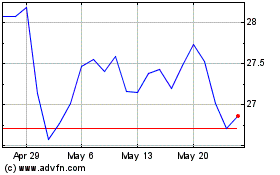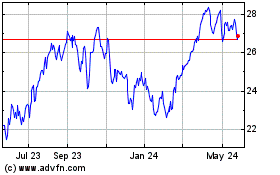Have The Natural Gas ETFs Finally Bottomed Out? - ETF News And Commentary
March 08 2012 - 6:01AM
Zacks
Although many energy commodities are surging, natural gas is
still feeling the pain of weak prices. The commodity remains under
pressure as new supplies of the key fuel are brought online all the
time, making the historic oversupply situation even more of an
issue. It also hasn’t helped that the winter has been unseasonably
warm across much of the nation, reducing demand for the product as
a key input for power plants as well.
These trends have pushed some more intrepid investors to predict
a bottom in natural gas prices, declaring that eventually, this
rough bear market in prices, which has seen the value of front
month natural gas contracts decline from about $12/mm BTU in 2008
down to its current price around the $2.5 mark, has to end. Yet
while investors continually call for the bottom in natural gas
prices, the key commodity just keeps falling. In fact, prices have
fallen by 50% in the past one year period and they are now near a
10 year low while inventories look to approach the highest winter
close since 1983 when they hit 2.1 trillion cubic feet (read
Commodity ETFs Plunge On Supply Forecast).
As a result of this, the outlook for natural gas still looks
shaky going forward, especially given broad uncertainty over CNG
and LNG implementation on a large scale. With this overhang,
natural gas may not have reached a bottom just yet, especially if
more gas supplies are brought online or if weather remains
unfavorable to demand. On the other hand, a supply shock—be it in
the form of weather or regulation—coupled with increased demand
from new gas uses could make some investors look back on this time
as the moment to buy (read Three ETFs For An Iranian Crisis).
While no one knows for sure which path will be the case, at
least investors still have a plethora of options to play the fuel.
Below, we highlight some of the pros and cons of each approach as
well as a brief discussion of what investors can expect to see in
each of these natural gas ETFs:
Natural Gas Futures ETFs
For investors seeking direct exposure to natural gas prices, the
United States Natural Gas Fund (UNG) will be tough
to beat. The fund sees volume of close to four million shares a day
and has AUM of nearly $900 million, suggesting tight bid ask
spreads for the product. However, the fund has seen heavy contango
in recent months and years, coupled with the general decline in
value of natural gas prices. Thanks to this, UNG has lost about 52%
over the past 52 weeks including more than one-third of its value
in the past three months alone (see Inside The Forgotten Energy
ETFs).
Beyond UNG, there are a number of other options as well,
including the fund’s cousin the United States 12 Month
Natural Gas Fund (UNL).
This product sees slightly less in contango thanks to its approach
which spreads out exposure across 12 months of the curve, helping
to push the fund down ‘just’ 42.5% over the past 52 weeks, although
it does see tiny volumes in comparison. In addition to this choice,
investors also have the iPath DJ-UBS Natural Gas TR Sub
Index ETN (GAZ) for
those seeking the ETN structure, Teucrium’s Natural Gas
Fund (NAGS) which
spreads out exposure across multiple points on the curve, and the
iPath Seasonal Natural Gas ETN
(DCNG) which only offers
exposure to December contracts.
Natural Gas Equity ETFs
Given the uncertain future of the commodity, as well as recent
price weakness, some investors may want to play natural gas via an
equity route instead. This path may see less volatility than
commodities, and also help to avoid the contango issue too. On this
front, investors currently have two options; the First
Trust ISE Revere Natural Gas Index Fund
(FCG) and the brand new
Market Vectors Unconventional Oil & Gas ETF
(FRAK).
FCG holds 30 securities in total, charging investors 60 basis
points a year for access to its basket of natural gas focused
stocks. The product has a heavy focus on exploration and production
firms as these securities make up nearly 80% of the total exposure.
From a performance perspective, the fund is down just 14% over the
past year but is up 6.6% in the past quarter. FRAK on the other
hand could see some of same key risk/reward points as FCG but could
also see a heavy influence from the oil shale market as well.
Still, the product has a similar 80% focus on energy exploration
companies so it could be another way to play the natural gas market
(read Is HAP The Best Commodity Producer ETF?).
Short Natural Gas ETN
Given the oversupply situation and the lack of new uses for
large amounts of natural gas at this time, some may want to take a
short position in natural gas. Until recently, this was tough to do
with ETPs but appears to have changed with the launch of the
VelocityShares 3x Inverse Natural Gas ETN
(DGAZ). The note looks
to provide triple the daily inverse performance of natural gas
futures while collateralizing the investment with a purchase of
short-term Treasury bills. This could make DGAZ a great pick for
those who think that the oversupply situation in the natural gas
market has further to run and that prices of the important fuel are
headed sharply lower again this year.
Want the latest recommendations from Zacks Investment Research?
Today, you can download 7 Best Stocks for the Next 30
Days. Click to get this free report >>
To read this article on Zacks.com click here.
Zacks Investment Research
Want the latest recommendations from Zacks Investment Research?
Today, you can download 7 Best Stocks for the Next 30 Days. Click
to get this free report
First Trust Natural Gas ... (AMEX:FCG)
Historical Stock Chart
From Apr 2024 to May 2024

First Trust Natural Gas ... (AMEX:FCG)
Historical Stock Chart
From May 2023 to May 2024
